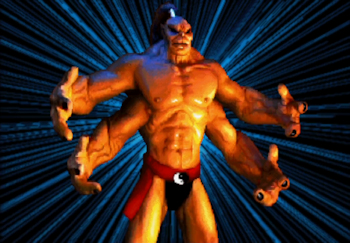
Mortal Kombat wisely featured Goro in one of its attract screens, inspiring players to keep pumping quarters in to see what he looked like in action.
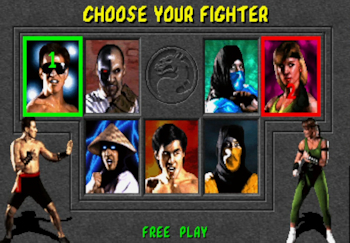
Since there's only seven playable characters, my initial impulse was to just capture each character's fatality.
Obviously I decided against it. 
Mortal Kombat infamously used palette swapped sprites to squeeze one more character out of the limited ROM space, a practice they would take to ridiculous extremes in later games.
Review by Jay Wilson A long time ago in an arcade far far away, a gentleman once showed me a simple cheap trick to beating the artificial intelligence in Mortal Kombat 1: jump punching with Raiden. Endless jump punching. Raiden’s jump punch seems to come out faster than most other characters so at close but not quite point blank range, Raiden can jump forward, hit a standing opponent, land, and jump punch again. Perhaps jump is a little misleading since Raiden barely leaves the ground. Hop punching? Pogo punching? I digress. Once you find the magic Goldilocks distance, it doesn’t matter if they block or walk into it. Raiden stays in range to do it again and again, and the AI rarely wises up to duck and uppercut. Even when you do screw up and jump over their head, the game rarely punishes you and lets you go right back to perpetual jump punches from the other side. Eventually, Raiden will chip away at their life until it comes time to “Finish him!” Multi-opponent endurance rounds? No problem. The sub-boss, Goro? Piece of cake. The final boss, Shang Tsung? Zzzzzzzzz. The hardest opponent is Liu Kang because he is the shortest making him the character you’re most likely to miss. I successfully and effortlessly beat every arcade machine I ran across with this trick. I did this on the crappy bloodless Super Nintendo port. I did this again on the much superior MS-DOS port. A decade later, I replicated it yet again on MAME emulators and on the Mortal Kombat: Deception Collector’s Edition bonus disk. And a decade after that I used it to breeze through the Mortal Kombat Arcade Collection for PC & XBox Live to grab the screens you see before you now. And with the exception of games with annoying button-reading AI such as Ultimate Mortal Kombat 3 and Soul Calibur III, I haven’t used a cheap gimmick like that before or since. Even if I know of an exploit, I like to play my way with my attacks and my combos the way I want to put them together. I like to play reckless. I like to experiment, try things, and find the craziest aggressive tactics I can get away with. If there’s a flashy move or attack I think looks wicked, I play for style points at the expense of effectiveness all day long. And I like to include as much variety into my arsenal so that onlookers at the arcade would form a crowd around me and watch as I played ... ... except in Mortal Kombat. Why? Well, what made Mortal Kombat? It wasn’t the fighting engine. The stilted and leisurely fighting in MK1 that bordered on slow motion, quite frankly, sucked. Most special moves were suicide waiting to happen due to the ridiculous recovery time. For example, if Scorpion misses with his spear, you can get in a few rounds of Street Fighter II on the next cabinet over and still have time to nail him from a full screen away. And on top of that some moves—such as Kano’s ball and Raiden’s superman—had bounce back as well which conveniently positioned their own heads in the metaphorical guillotine for when their opponents got back from the Fatal Fury machine. Combos existed exclusively in the corner as pretty much nothing linked together mid-screen with the sole exception of jump-in attacks, and even then you’re looking at two hits maximum (unless you’re Scorpion in which case the spear allows for a third hit.) And speaking of jump-in attacks, if you happen to jump over your opponent’s head, you’ll attack the wrong way and again end up giving your opponent two eternities to decide on how to punish because your character doesn’t turn around mid-jump. 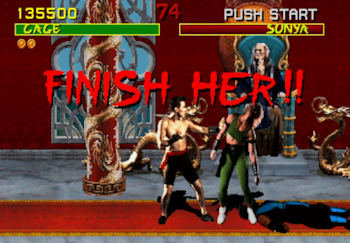
Right before the sub-boss, Goro, players face three Endurance Matches against not one but two opponents. However, you only get to finish the second one.
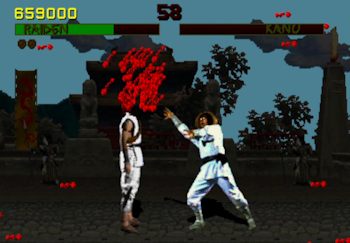
Both 16-bit console ports were censored, but at least the Sega Genesis version had the original fatalities locked behind a code. SNES owners were stuck with the lame bloodless fatalities and sweat.
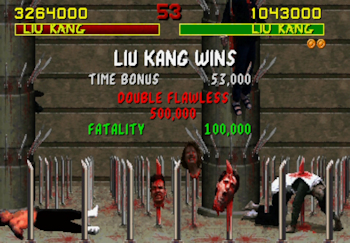
Mortal Kombat 1 featured a hidden character, Reptile, accessed by getting two flawless victories and performing a fatality on The Pit stage without pressing block in single player ... but only if you see silhouettes across the moon.

Every few matches, Mortal Kombat presented players with a simple mini-game. Tapping low punch and low kick would build meter. Block would strike.
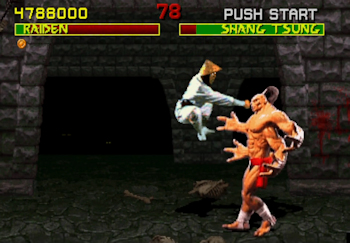
It looks dire, but precisely seven seconds later I beat the game using nothing but jump punches. Shang Tsung (as Goro) walked into every single one of 'em.
In fairness, though, this was the early days of fighting games, and I did play Mortal Kombat extensively (some might argue obsessively) along with Street Fighter II and Samurai Shodown both in the arcades, on the Super NES, and on PC. I had fun with all of them. However, I don’t feel time has been kind to any of them; the genre has evolved and matured since then, and so have I. Back in 1992, my idea of playing a competitive fighting game was to throw out as many special moves that I possibly could—play flashy and play to the crowd—and Mortal Kombat catered to this more so than any other fighter with its vast array of identical normal moves. Uppercut? Down + low/high punch. Sweep? Back + low kick. Roundhouse kick? Back + high kick. And let’s not forget the monotonous near-identical barrage of left-right-left-right punches each character possessed. Sure, Street Fighter II had similar moves with similar properties tied to identical button inputs—I’m not criticizing that—but press down and roundhouse in SF2 and watch Ken do a single sweep whereas Guile sweeps twice; Chun-li balances on one arm while striking out with both legs; and Dhalsim slides across the ground—all of them trigger a knock down, but at the same time they all have very different speeds, ranges, and varying properties. Dhalsim’s low roundhouse can be used as an escape since it physically moves him while making him a smaller target; Chun-li’s can go over other character’s sweeps to strike them while keeping her safe; Guile strikes twice, but if his opponent jumped over him, he’s screwed because he’s locked into the move. Mortal Kombat? Same motion, different actor. One could argue that technically different actors brought different speeds, ranges, and hit boxes—and they’d be right—but I would argue that if you have to break out the magnifying glass to see them then there’s not enough difference. The special moves really were about the only thing setting the characters apart. Especially the fatalities. Yes, fatalities made Mortal Kombat first and foremost. We played so we could rip Sonya’s still beating heart out of her chest with Kano, to glitch uppercut Raiden’s head off two or three times with Johnny Cage, to unmask Scorpion and breath fire on Sub Zero, and to shake our head and sigh at Liu Kang’s lame ass scissor kick/uppercut combo that only managed to kill on the Pit stage. I wouldn’t be surprised if most casual MK players picked their character solely by their fatality. I know I did. And so did the people I played. Anyway, against other human beings, there were no shortcuts to the fatalities; I had to play a lot more carefully and conservatively—aggressive but competitive—even though I still tried to cram as many unsafe special moves into a match as I could get away with. However, against the CPU? Raiden’s jump punch was a quick and easy way to skip the crap and get to the good stuff, and as chance would have it, Raiden also had the best fatality with Johnny Cage coming in second who, by the way, could use the same trick as Raiden and is actually better at it. Like I said, we picked our characters for their fatalities, not their gameplay. While the violence had a lot to do with Mortal Kombat’s success, it wasn’t just the fatalities nor the splatterings of blood that came with every uppercut and mysteriously vanished once they hit the ground. Other fighting games existed in the nineties, some more violent and gory than Mortal Kombat. But MK also featured digitized actors instead of hand drawn sprites which made it feel more mature, more adult, and gave the fatalities more impact. We weren’t killing an illustration that didn’t exist like Bugs Bunny dropping an anvil on Daffy Duck’s head—that’s Saturday morning cartoon stuff. We were killing a real person in a fictionalize R-rated kind of way—this was Maniac Cop territory where we had to get a parent or legal guardian to get us in to the theater because we couldn’t buy tickets by ourselves. Sub-Zero ripping off his opponent’s head and dangling the photoshopped spine looked and felt so much darker and more intimidating than, say, the poorly animated dismemberment animations in Time Killers, a game whose sole selling point was the mid-match decapitations. Time Killers was still the colorful safe kiddie video game world where characters literally get back up after losing their arms and head and start the next round without so much as a Band-Aid. But Mortal Kombat meant business; it was the dark and dreary reality where fatalities came at the end of the match, and death was permanent ... until you put another quarter in and started over. And you know what? It wasn’t just the digitized actors either. Soon after Mortal Kombat, other forgettable (and forgotten) digitized fighting games cropped up such as Kasumi Ninja and, strangely enough, the home versions of Street Fighter: The Movie: The Game—both fading into obscurity almost as soon as they were released as their pathetic frame rate made all the characters move with an unnatural choppiness that shattered the suspension of disbelief which “realistic” live action sprites were supposed to conquer by virtue alone, once again proving the old truth in animation: motion is all important. If it doesn’t move right, no amount of design or detail can save it. Watch Johnny Cage’s shadow kick, Liu Kang’s thrust kick, Raiden’s superman, Sub-Zero’s slide, Scorpion teleport punch, Sonya’s handstand grab, and Kano’s spin ball—they’re all fantastic, yet believable. Mortal Kombat used digitized actors better than every other fighting game, bar none, to seduce the player’s suspension of disbelief by helping to set the tone and atmosphere of their game. 
After beating the game, Mortal Kombat does have a nifty credits sequence where the characters jump in one at a time as the actor's name is displayed.
And lastly, Mortal Kombat had a sense of humor. Sure, you could tear your opponents asunder, but the game really never took itself too seriously. Before it’s time to “Finish Him!”, Scorpion’s harpoons his prey and yells “Get over here!” as he pulls them in; Raiden’s flies at his opponent, pushing them halfway across the stage while screaming maniacal gibberish; and Johnny Cage takes a cue from BloodSport and punches his opponent in the balls while doing the splits. These iconic moves are not known for their in-game effectiveness. They’re funny and highly entertaining. But it’s more than that. Look in the background of the pit stage, and you’ll see Santa Claus and his reindeer ride past the moon. And everyone seems to forget Raiden’s ending where he grows bored with the tournament, invites other gods to participate, destroys the earth, and ends with the text “Have a nice day.” While Mortal Kombat may not have aged well and may have been overrated from the beginning, it did strike an intriguing mix and plant the seeds for greatness. And that, dear reader, is no small task. | ||||||||||||||||||||
|
| ||||||||||||||||||||
